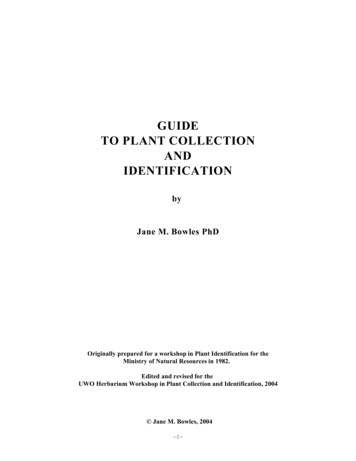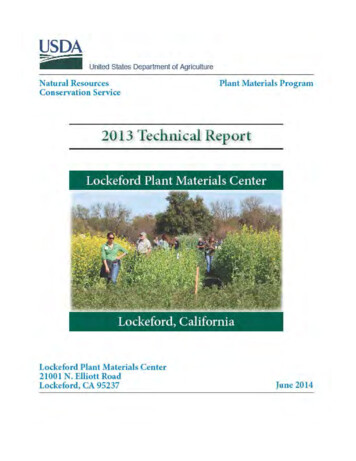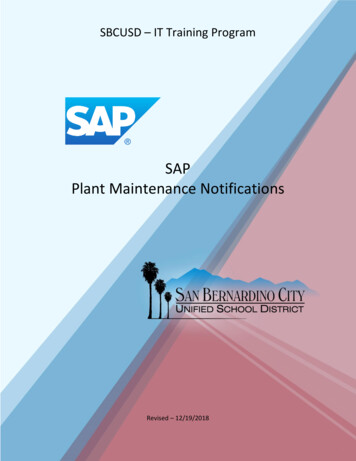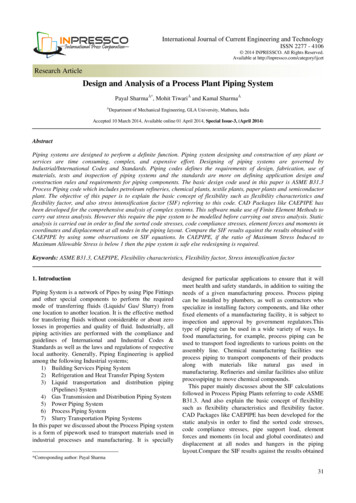
Transcription
GUIDETO PLANT COLLECTIONANDIDENTIFICATIONbyJane M. Bowles PhDOriginally prepared for a workshop in Plant Identification for theMinistry of Natural Resources in 1982.Edited and revised for theUWO Herbarium Workshop in Plant Collection and Identification, 2004 Jane M. Bowles, 2004-0-
CHAPTER 1THE NAMES OF PLANTSThe history of plant nomenclature:Humans have always had a need to classify objects in the world about them. It is the only meansthey have of acquiring and passing on knowledge. The need to recognize and describe plants hasalways been especially important because of their use for food and medicinal purposes. Thecommonest, showiest or most useful plants were given common names, but usually these namesvaried from country to country and often from district to district. Scholars and herbalists knew theplants by a long, descriptive, Latin sentence. For example Cladonia rangiferina, the common"Reindeer Moss", was described as Muscus coralloides perforatum (The perforated, coral-like moss).Not only was this system unwieldy, but it too varied from user to user and with the use of the plant.In the late 16th century, Casper Bauhin devised a system of using just two names for each plant, butit was not universally adopted until the Swedish naturalist, Carl Linnaeus (1707-1778) set aboutmethodically classifying and naming the whole of the natural world.The names of plants:In 1753, Linnaeus published his "Species Plantarum". The modern names of nearly all plants datefrom this work or obey the conventions laid down in it.The scientific name for an organism consists of two words:i) the genus or generic name,ii) the specific epithet.The generic name and specific epithet may be from any source, but they are always treated as Latin.The generic name is usually a noun. For example, the name Quercus is simply Latin for oak. Thespecific epithet is usually an adjective, but can be another noun or the name of a person. Thus inQuercus rubra, “rubra” means red; in Quercus prinus, “prinus” is another noun for another sort ofoak, and Quercus muehlenbergii is named after the eighteenth century minister and botanist G.H.E.Muhlenberg.The correct form of plant names:The scientific names of plants should always be underlined or written in italics. The generic nameis always written with a capital initial letter, and the specific epithet should always have a lower caseinitial letter. (Sometimes specific epithets honoring people are given a capital letter, but a smallletter is always correct and therefore safer). The name is only correct and complete if it is followedby the name of the person or people who first described it or assigned the name to it. Often, forconvenience, these names are abbreviated. For example, “L.” always stands for Linnaeus. Thecorrect names of the Red Oak, Chestnut Oak and Chinquapin Oak are:Quercus rubra L.Quercus prinus L. andQuercus muehlenbergii Engelm.The fist two species were described by Linnaeus, but the third was named by George Engelman-1-
(1809-1884), the German-American botanist whose collections are in the Missouri BotanicalGardens, St. Louis.Once a plant has been given its full, correct name in a text, further references to it (provided they areunambiguous) may be shortened to the initial letter of the generic name followed by the specificepithet. The authority may be dropped. Thus the three oak species may now be referred to as Q.rubra, Q. prinus and Q. muehlenbergii.Plant classification:Plants are classified according to their assumed relatedness. A unit of classification, at whateverlevel, is called a taxon (plural taxa). There is a strict hierarchy of taxa of which the species is thelowest natural unit. The hierarchy is: species, genus, family, order, class and division. There are,however, several possible subgroups at each level. An example from Radford et al. (1974) illustratesascending ranking:"Quercus alba L., Qu ercus laevis W aiter, Qu ercus falcata Michaux and Q. bicolor W illdenow arefour species in the genus Quercus. Quercus L., Fagus L. and Castanea Miller are three genera in thefamily Fagaceae; Fagaceae and Betulaceae are two families in the order Fagales. Fagales, Urticalesand Piperales are three of the many orders in the sub-class Dicotyledonidae in the classAngiospermopsida, which is in the sub-division Spermatophytina in the division Tracheo phyta."Field botanists are mostly concerned with the sub-class and at the family level and below.The use of common names:Latin names often seem long and unpronounceable, and the system of naming (nomenclature) iscomplicated and involved. So why use them? Why not use common or vernacular names that areeasy to remember and usually have a meaning in everyday language? Some of the reasons are listedbelow.1. Common names are not universal. They are usually only applicable to a single language. Thusthe same plant may have numerous common names. Canadian government employees should beaware that the Chinquapin Oak is also known as Chene a Chinquapin and Chene Jaune.2. In most parts of the world only a very small proportion of the species have any common names.Insistence on calling plants by common names usually means that the scientific name is translatedor species are lumped under a generic name. The resulting names are often as cumbersome as theLatin descriptions used until Linnaeus' time. Carex aenea Fernald (or simply Carex aenea) iscertainly no harder to remember than "Fernald's Hay Sedge" which is one of its common names.3. The convention of a generic name and a specific epithet is not used for common names.Sometimes closely related plants have completely different names. For example, in the genusEupatorium, E. maculatum L. and E. purpureum L. are known respectively as Spotted Joe-PyeWeed, and Sweet Scented Joe-Pye Weed, but E. fistulosum Barrat goes under the name ofTrumpetweed, E. rugosum Houtt. is known as White Snakeroot and E. perfoliatum L. is also calledBoneset . There is no indication from the name that they are all in the same genus.-2-
4. It is quite common that two unrelated species have the same common name. For example, twocommon woodland plants are Snowberry and Creeping Snowberry. The first, Symphoricarpos albus(L.) Blake is a relative of the honeysuckles, whereas Creeping Snowberry (Gaultheria hispidula(L.)Muhl.) is in the Ericaceae or Heath Family.The case against common names is exemplified by the genus Pyrola, common plants of the northernwoodland. The common names for Pyrola are Shinleaf or Pyrola. The name Shinleaf on its ownimplies one particular species, Pyrola elliptica Nuttal, but may also refer to the genus. Pyrolaasarifolia Michaux is known not only as Pink Pyrola or Pink Shinleaf, but also as Bog Wintergreen.The name Wintergreen also applies to at least five other genera. Wintergreen (Gaultheriaprocumbens L.) is also known as Checkerberry. Chimaphila maculata (L.) Pursh has the commonnames Spotted Wintergreen or Striped Wintergreen, and Monesis uniflora (L.) Gray is calledOne-flowered Wintergreen or One-flowered Pyrola. These three, at least, are in the same family.Less closely related are Trientalis borealis Rafinesque, which is known both as ChickweedWintergreen and Starflower, and Polygala paucifolia Willdenow, which is called Fringed Polygalaand Gaywings as well as Flowering Wintergreen.The meaning and origin of plant names:One of the reasons why people shy at scientific names is that they are unfamiliar, and sometimesrather long and they may seem difficult to pronounce. Understanding and therefore rememberingnames of plants becomes much easier, simpler, and more interesting, if the meaning or the origin thename is known. Many of the specific epithets are very common. They describe color, shape ofleaves, habit, number of parts, size, habitat, place of origin and so on. Most of these are Latin, butunfortunately, to confuse the issue, some are Greek. For example, epithets describing four leavescould be either quadrifolius (Latin) or tetraphyllus (Greek), they both mean "four-leaves".Nevertheless, many of the Greek and Latin words which go to make up species epithets are theorigins of many English words, and the meaning of names can often be interpreted by someone withno Classical background. A list of words common in species epithets is given in Appendix I.Specific epithets which honour people may be recognized because they end in ‘ii’ if the name endswith a consonant, ‘i’ if the name ends with a vowel except a, and ‘e’ if the name ends with an a.Naming a plant after a colleague was (and is) a good way of complimenting him or her, especiallyas, if he or she was a botanist, the favour might be returned. The names of some North Americanspecies of the genus Sphagnum conjure up a wonderful image of a mid-nineteenth centurybryological ring:Sphagnum girgensohnii Russow;Sphagnum russowii Warnstorf;Sphagnum warnstorfii Russow; andSphagnum wulfianum Girgensohn.Generic names are not always so easy to interpret, but there is no reason why Carex should be moredifficult to learn that Sedge, or Prunus than Cherry or Pinus than Pine. Linnaeus showed unlimitedimagination in inventing names for the plants he was cataloguing. Many, such as Quercus, retainedtheir ancient Latin names, others merely described some aspect of the plant. Aster, for example,means "star" and clearly describes the flowers. Sometimes Linnaeus was much more fanciful. BogRosemary, known at that time as Erica palustris pendula., caught his attention. He imagined that-3-
the beautiful flesh-pink flowers imitated the"beauty of a fine female complexion". Theplant, growing on hummocks in the middle ofbogs,reminded him of Andromeda,legendary princess of Ethiopia, whose beautylasted only as long as she was a virgin. Inorder to save her country from a terrible floodshe was chained to a rock and left to beravaged by a dreadful sea monster. Linnaeussaw the sea monster in the toads thatinhabited the bogs in which he found theplant. He named the genus Andromeda afterthe distressed virgin (Black, 1979).Often Linnaeus named new genera after friends and colleagues. In 1748, on Linnaeus'recommendation, the Swedish Royal Academy sent Peter Kalm, a former student, on a collectingtrip to North America. When he returned in 1751 Linnaeus honoured him by naming the Laurels‘Kalmia’ after him. One of his favourite plants, the beautiful and delicate Twinflower, Linnaeuskept for himself and named Linnaea borealis L.Word endings:Because plant names are Latin or Latinized, unlike English words, they have a gender. In most casesthe ending of the generic noun indicates its gender. For example, nouns ending in -a are alwaysfeminine, those ending in -us are often masculine, and -um indicates neuter. In Latin, an adjective,or other modifier, has to have the same gender as the noun it modifies, so that the ending of thespecific epithet usually agrees with ending of the generic noun, for example, Kalmia ployfolia,Lathyrus latifolius and Vaccinium angustifolium. Most plant names, however, are feminine,including many whose generic name ends in -us. The commonest endings are listed -er-ra-rum-is-is-is-r-ris-reSome endings remain the same for all three genders, so that the specific name is the same regardlessof the gender of the noun. Some examples are -ans, -ens, -x, and -or (Radford et al. 1974). Not allplant names obey these rules, however, and exceptions can always be found.-4-
CHAPTER 2PLANT COLLECTINGThe purposes of collecting:Today there are two main reasons for collecting plants. The first is to obtain records and specimensof plants, either for a personal collection or to be stored in an herbarium. Properly run herbariawhere specimens are suitably stored and catalogued have great scientific value. They are almostalways pleased to accept good, correctly labeled specimens and are generally willing to allow seriousworkers access to their collections. The merits of personal collections are less obvious. Smallcollections of common plants can have great value as reference for identification. Wide scalegathering of rare of endangered plants for personal collections should be discouraged however. InEngland, over-enthusiastic collection by amateurs, together with loss of habitat has caused theextinction or near-extinction of a number of plants, especially orchids. It is now illegal to pick orcollect any plant in many jurisdictions without the consent of the landowner. Increasingly manyareas in the world require a permit for plant collecting. You should always check with the landownerand the law before collecting plants.The second major reason for plant collecting is in order to later identify an unknown specimenencountered during fieldwork. Often these specimens consist of small, atypical plants with noflowering or fruiting parts. As herbarium specimens they are often next to useless. Nevertheless,any vegetation survey should include, where possible, collection of at least one specimen of eachspecies encountered. This is known as the voucher collection and should either be kept by theworker for future reference if needed, or stored in a local herbarium.What to look for in a specimen:Specimens for collection should be as complete as possible. Ideally flowers and fruit should beincluded, as well as vegetative parts. Clearly, in most cases, this is impossible since ripe fruit andflowers do not usually occur at the same time. Often, however, remains of growth from the previousyear can be found at the base of the plant or on another specimen nearby. Only collect fruits or seedsif you are certain that they belong to the same plant or the same species.Specimens should be typical and healthy, with at least some fully expanded leaves where possible.Avoid taking diminutive individuals because they fit into a press more easily or are easier to reach.Take the plant from its typical habitat. If a species normally grows in woodland, do not collectspecimens growi
Plants are classified according to their assumed relatedness. A unit of classification, at whatever level, is called a taxon (plural taxa). There is a strict hierarchy of taxa of which the species is the lowest natural unit. The hierarchy is: species, genus, family, order, class and division. There are, however, several possible subgroups at each level. An example from Radford et al. (1974 .











